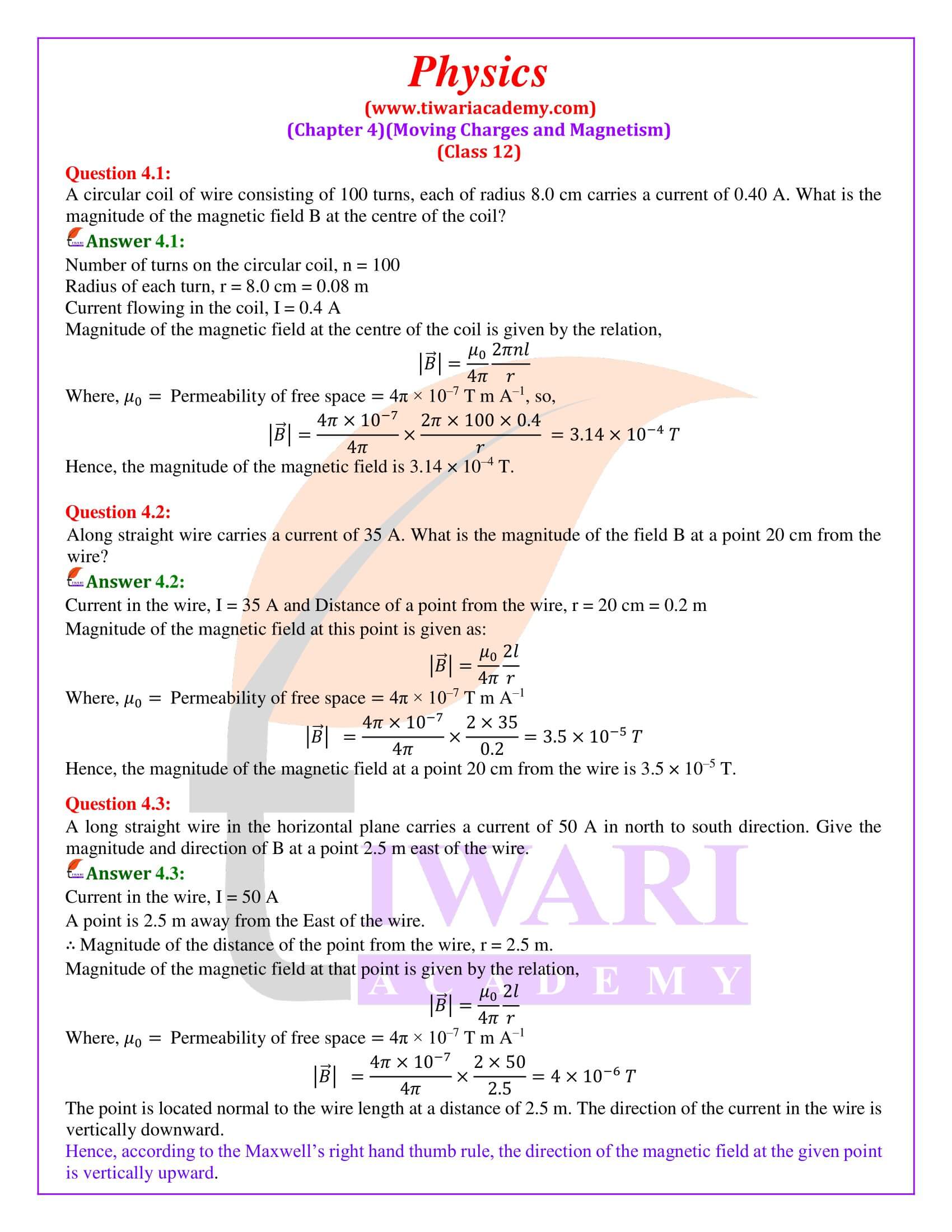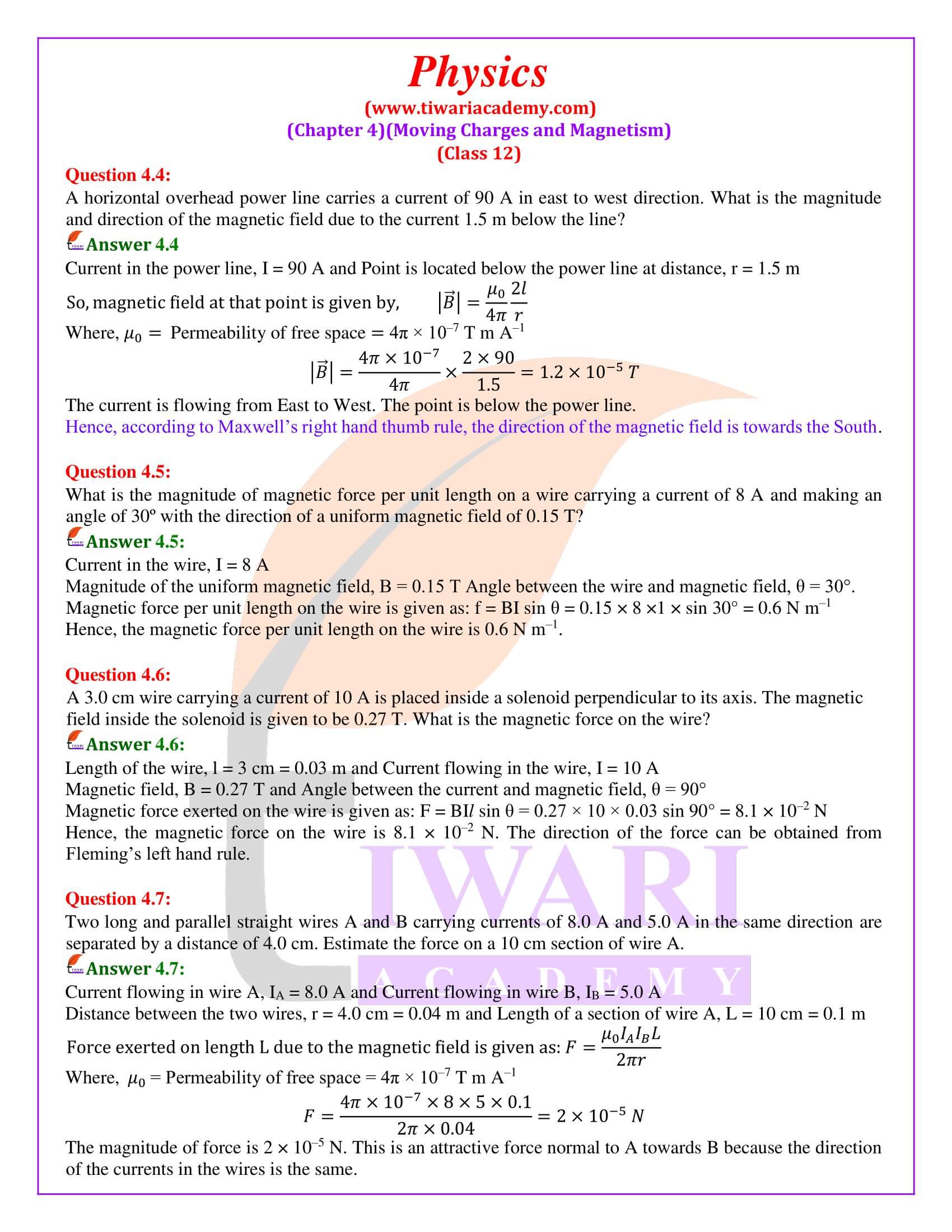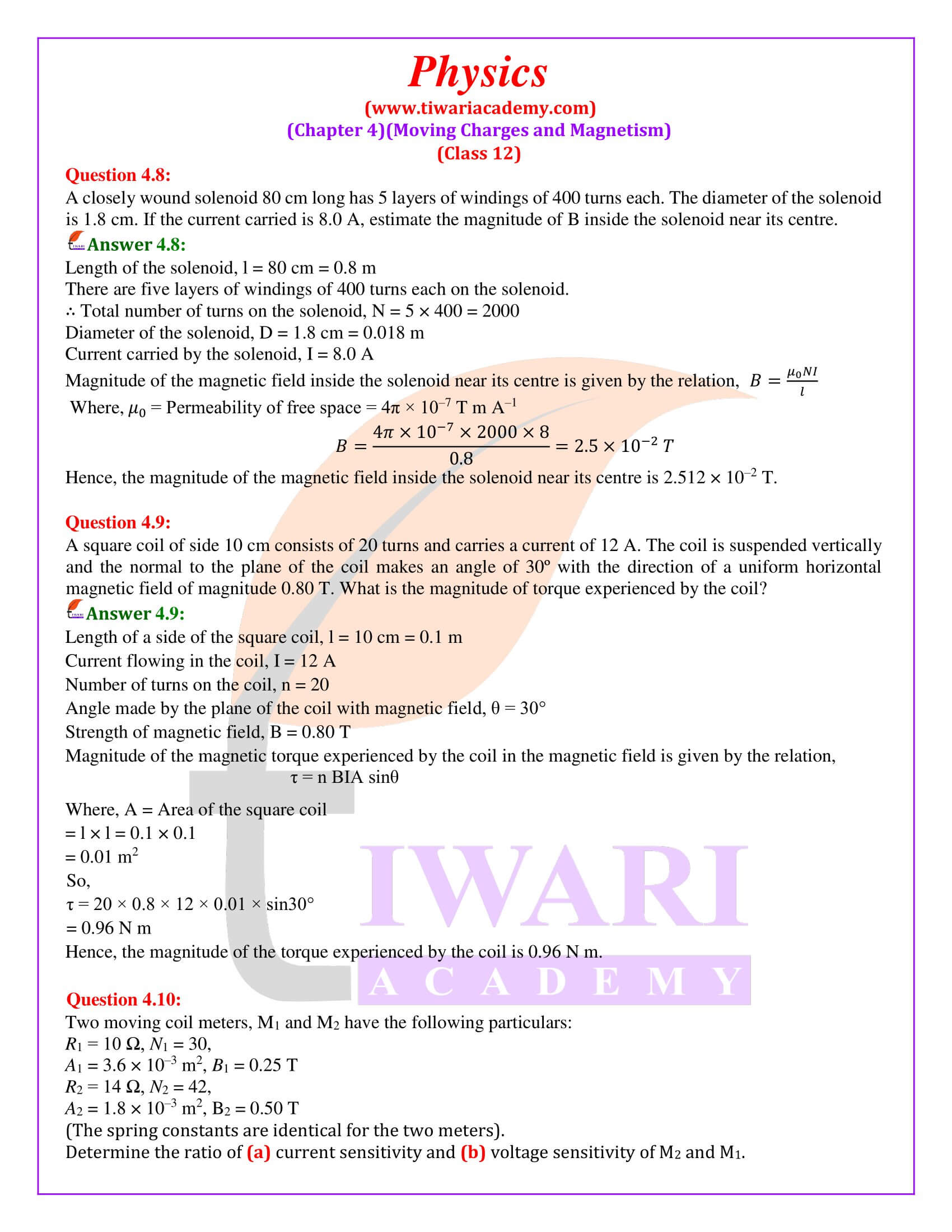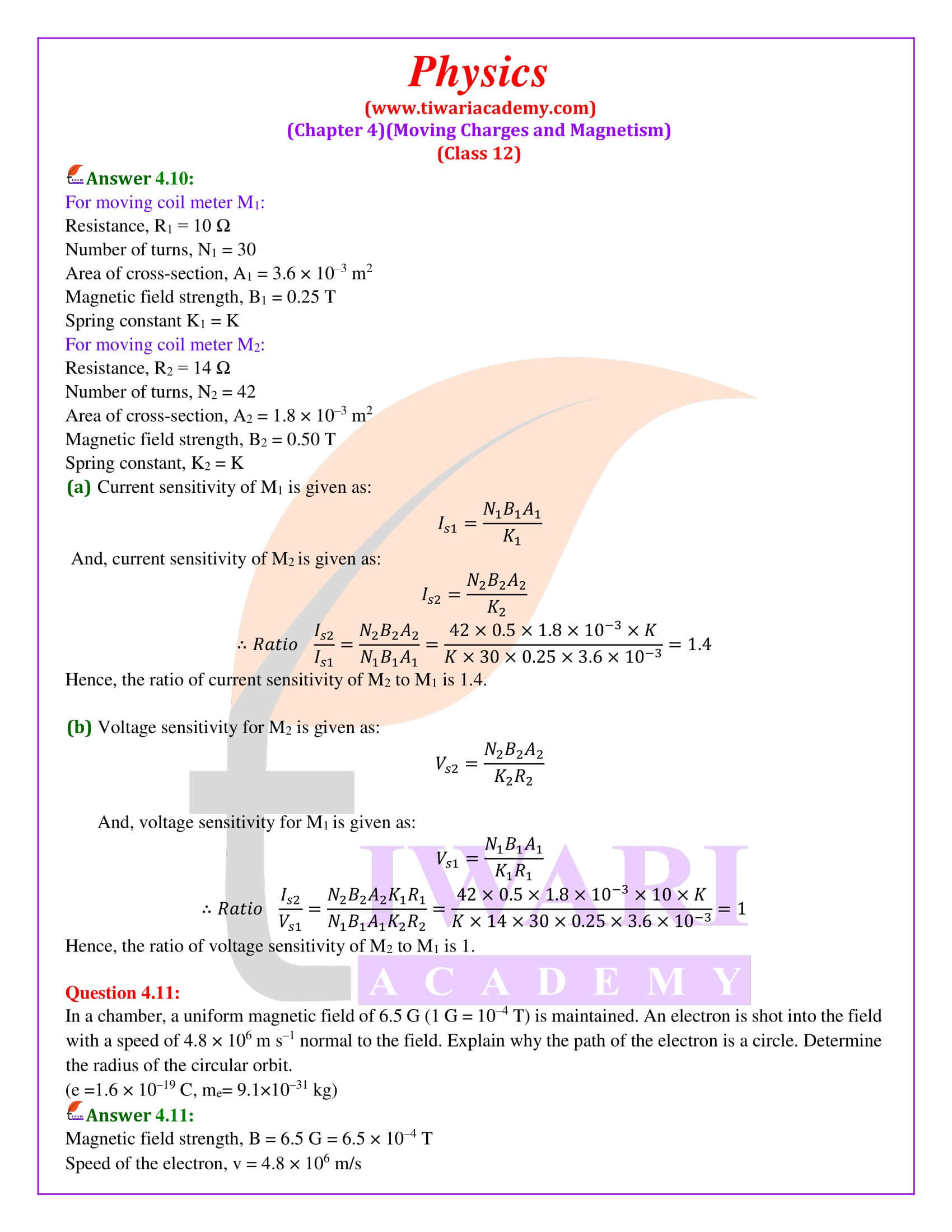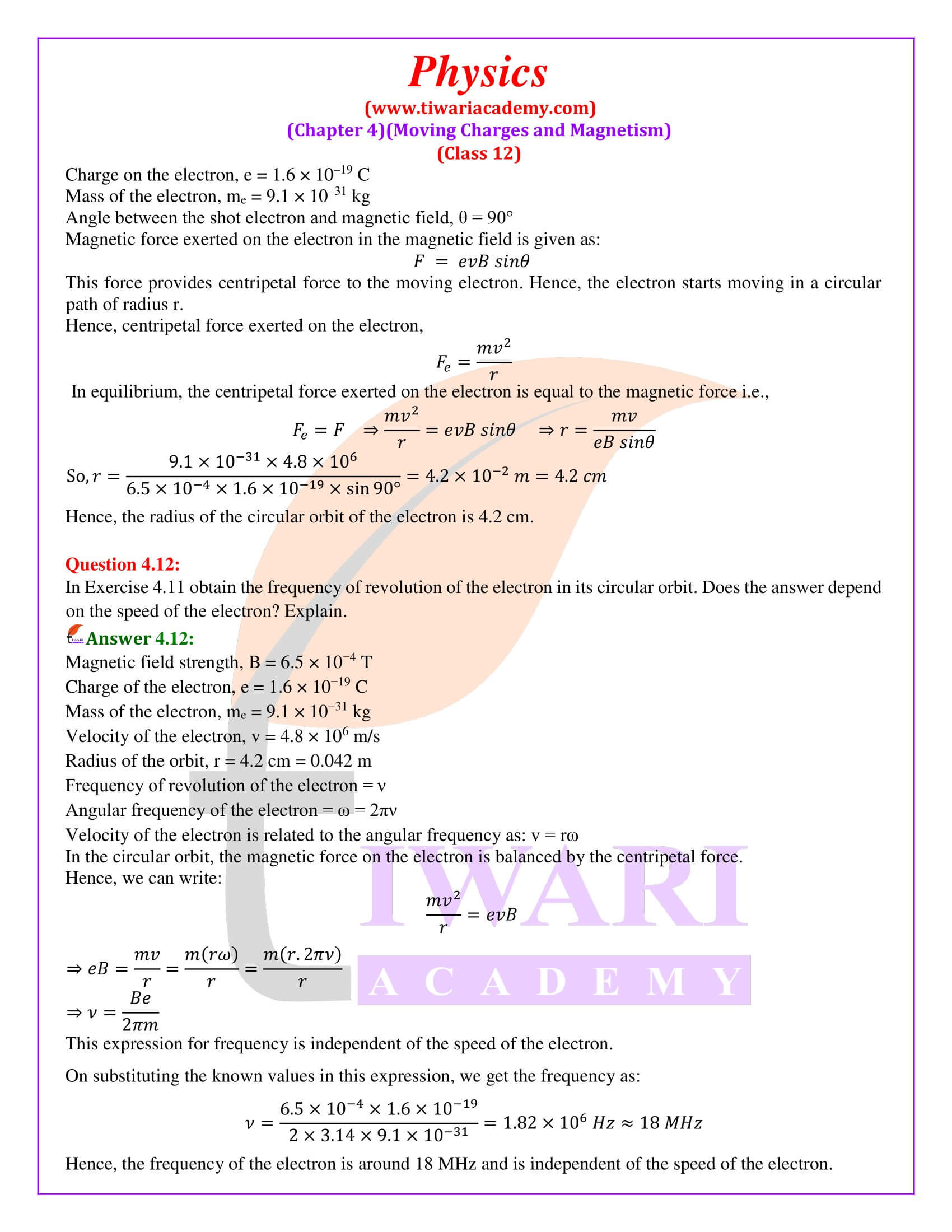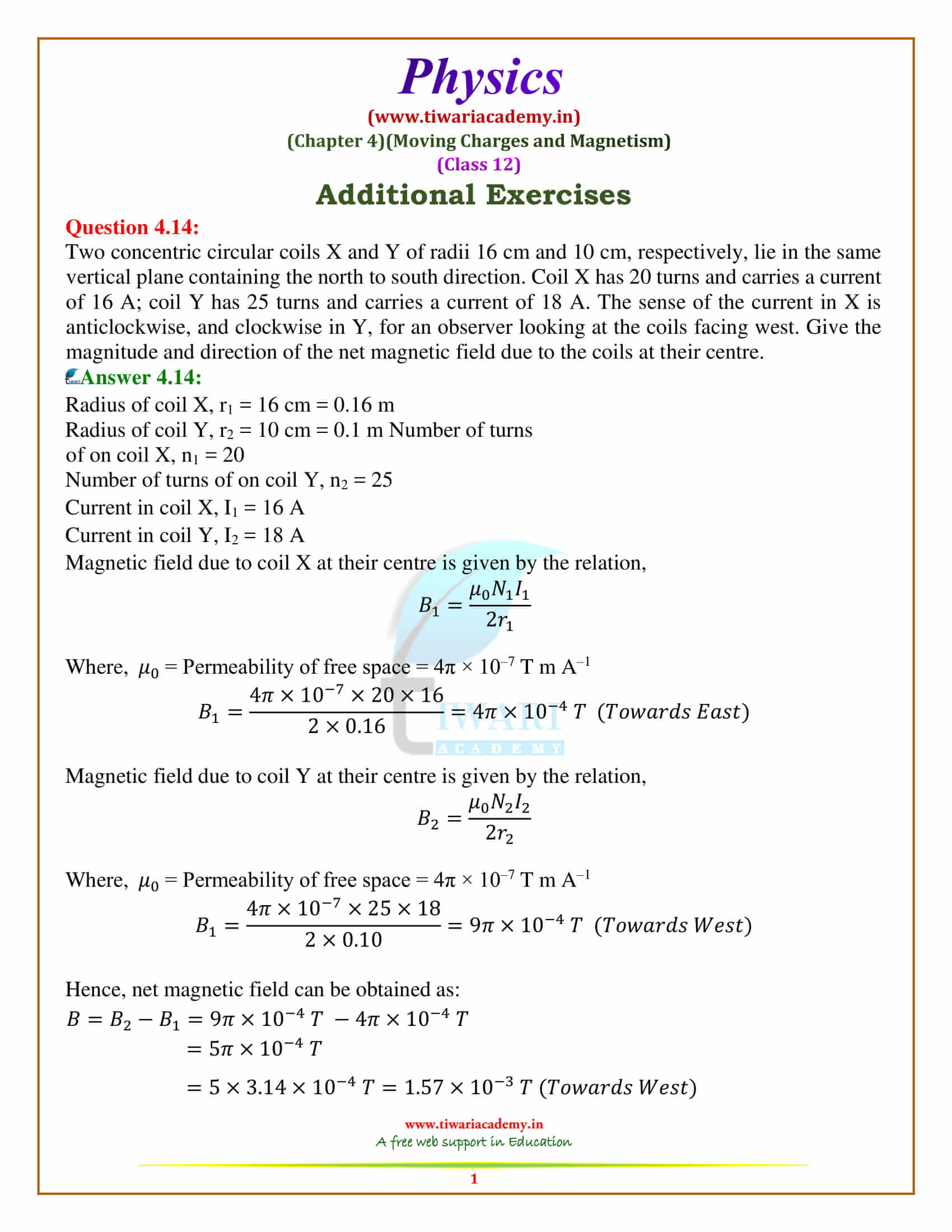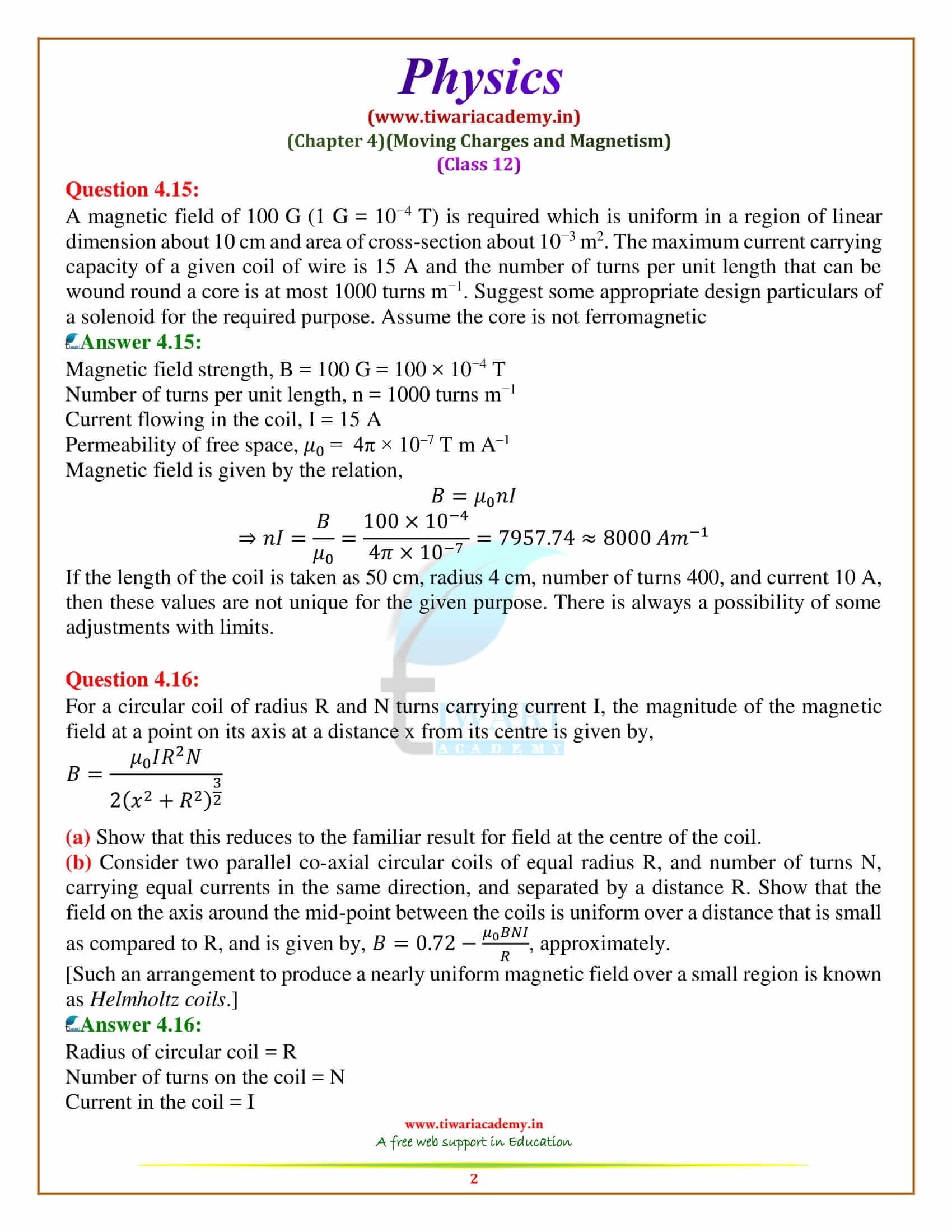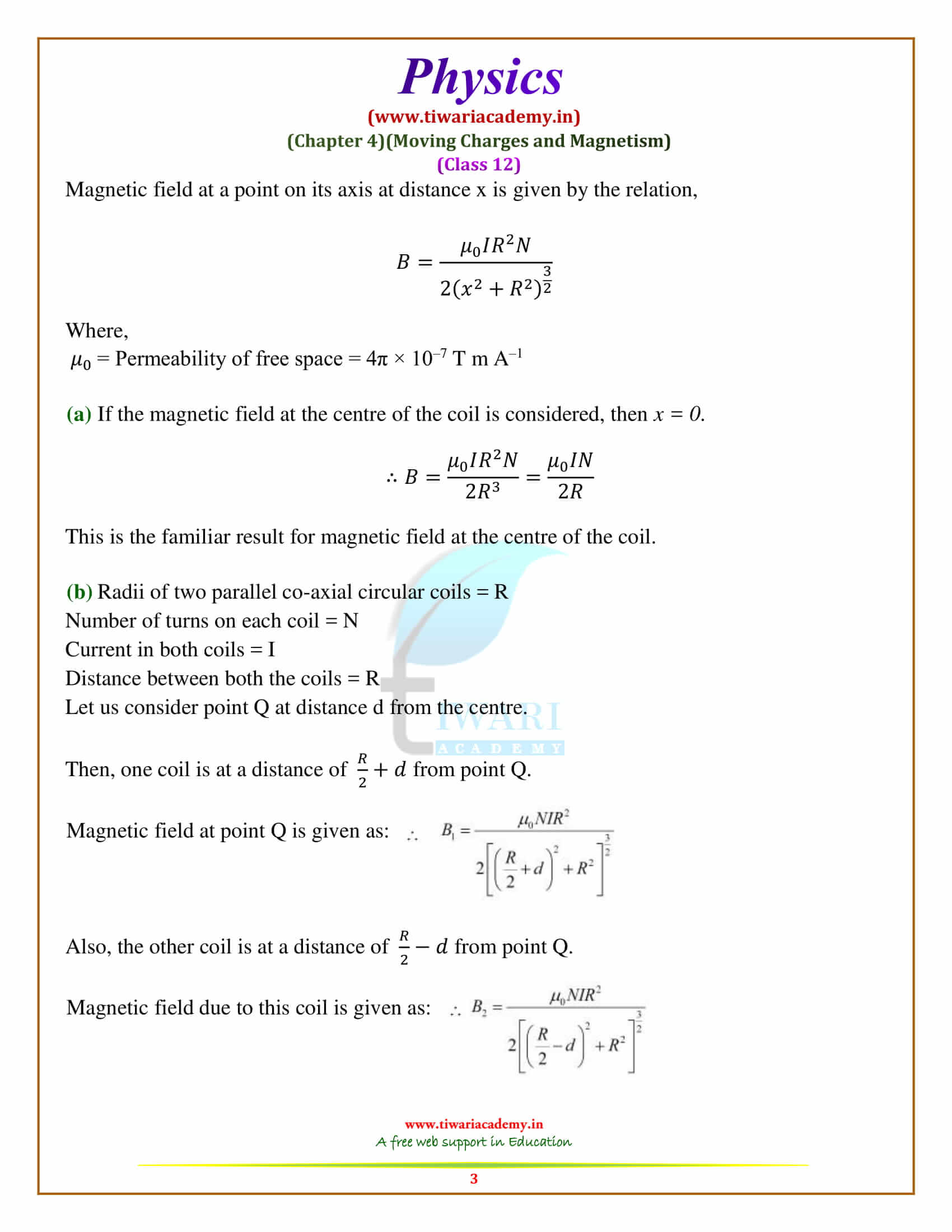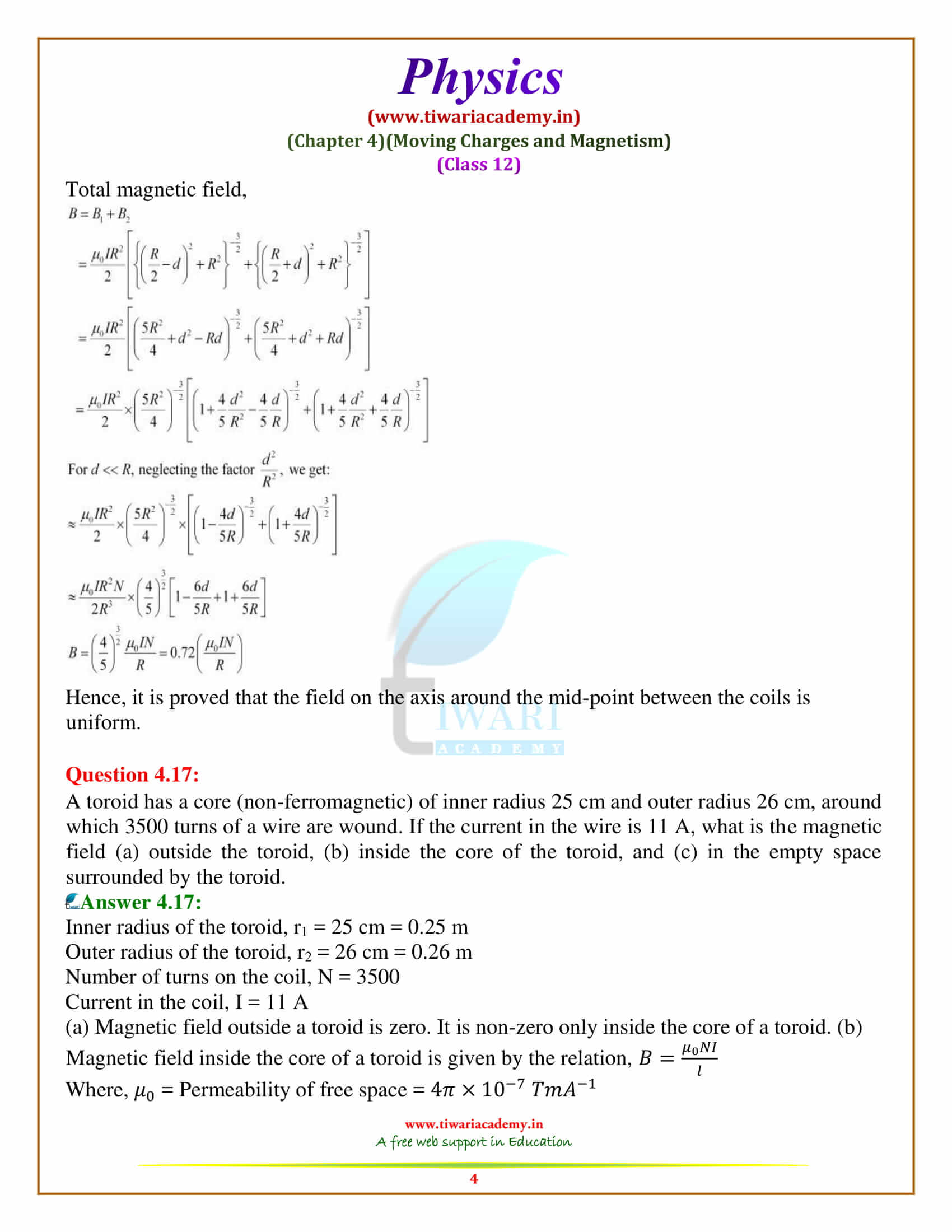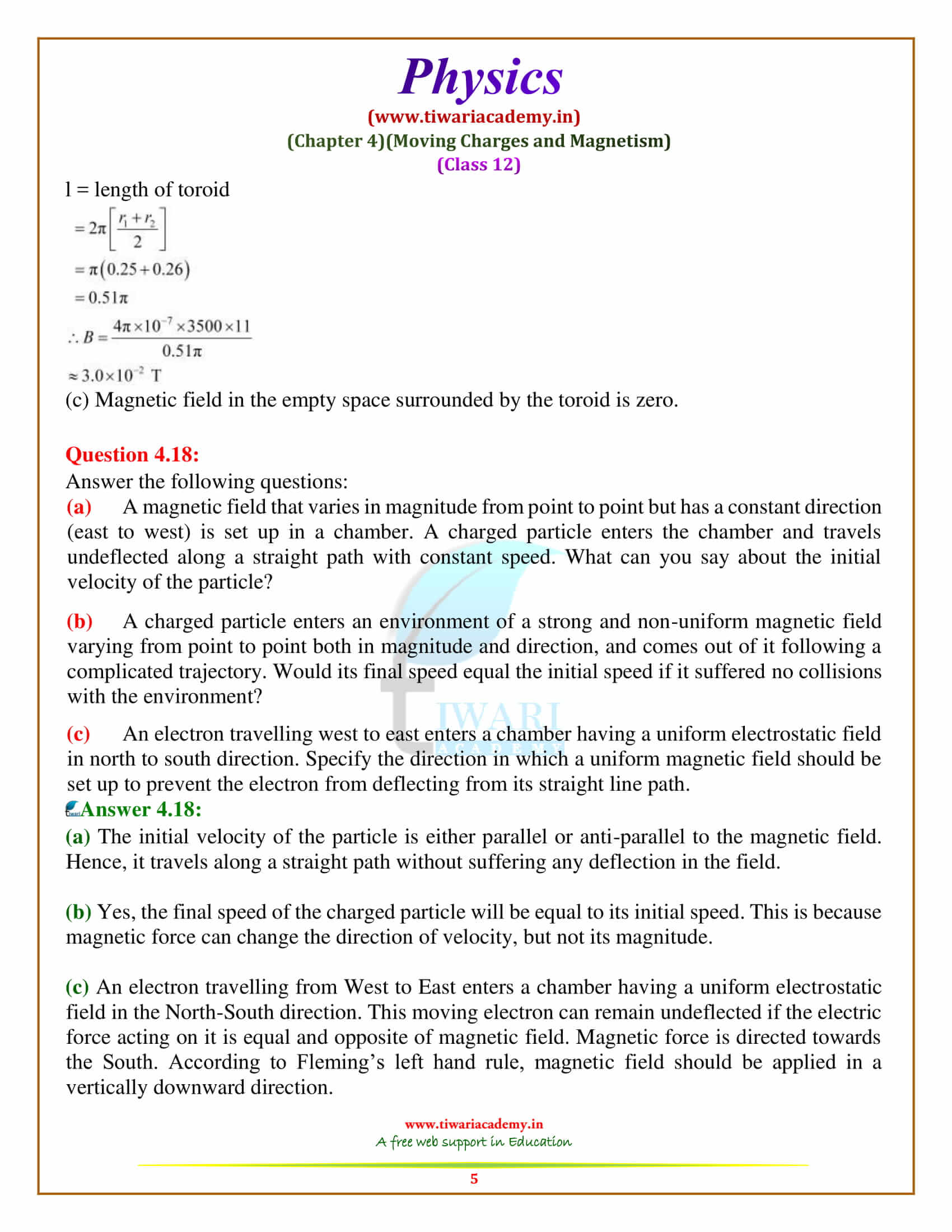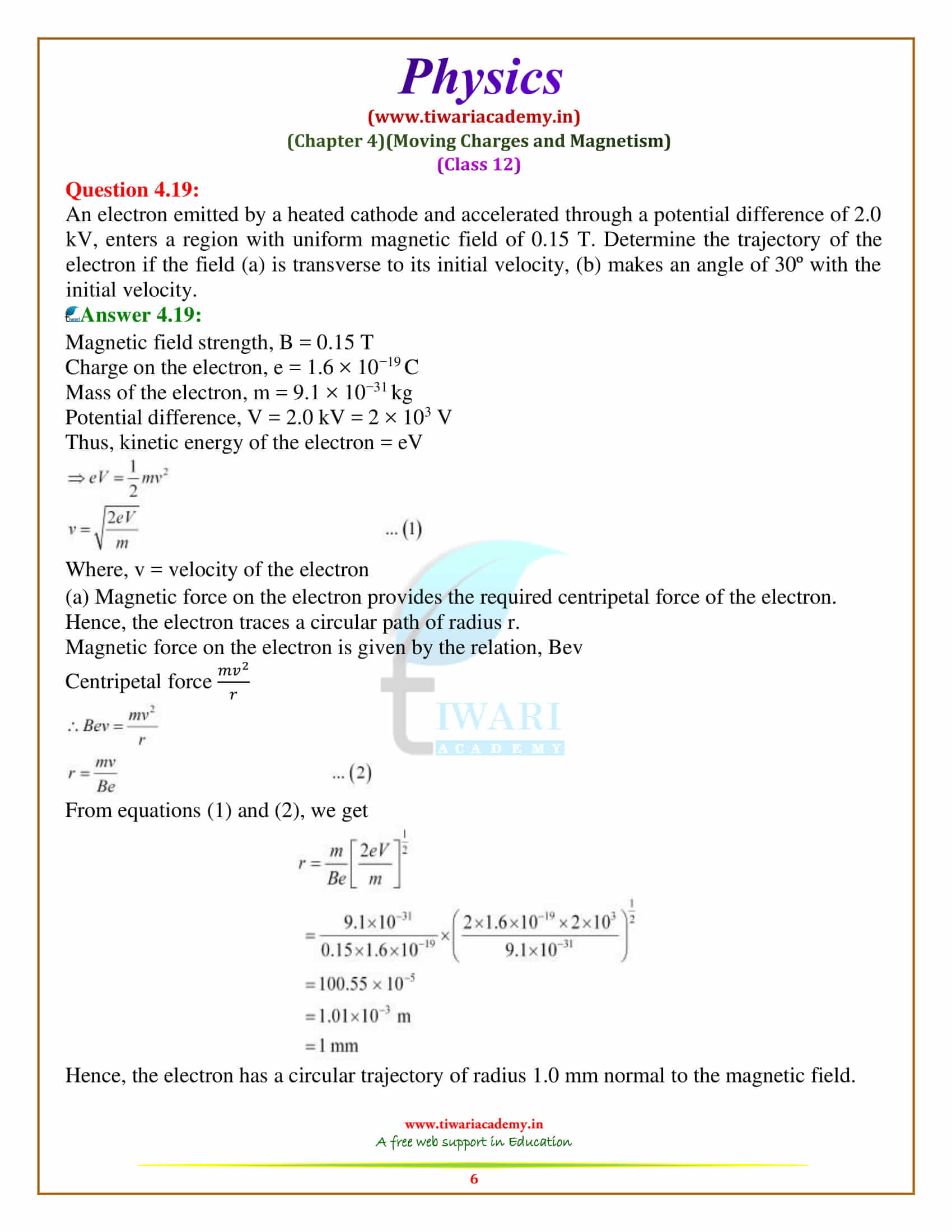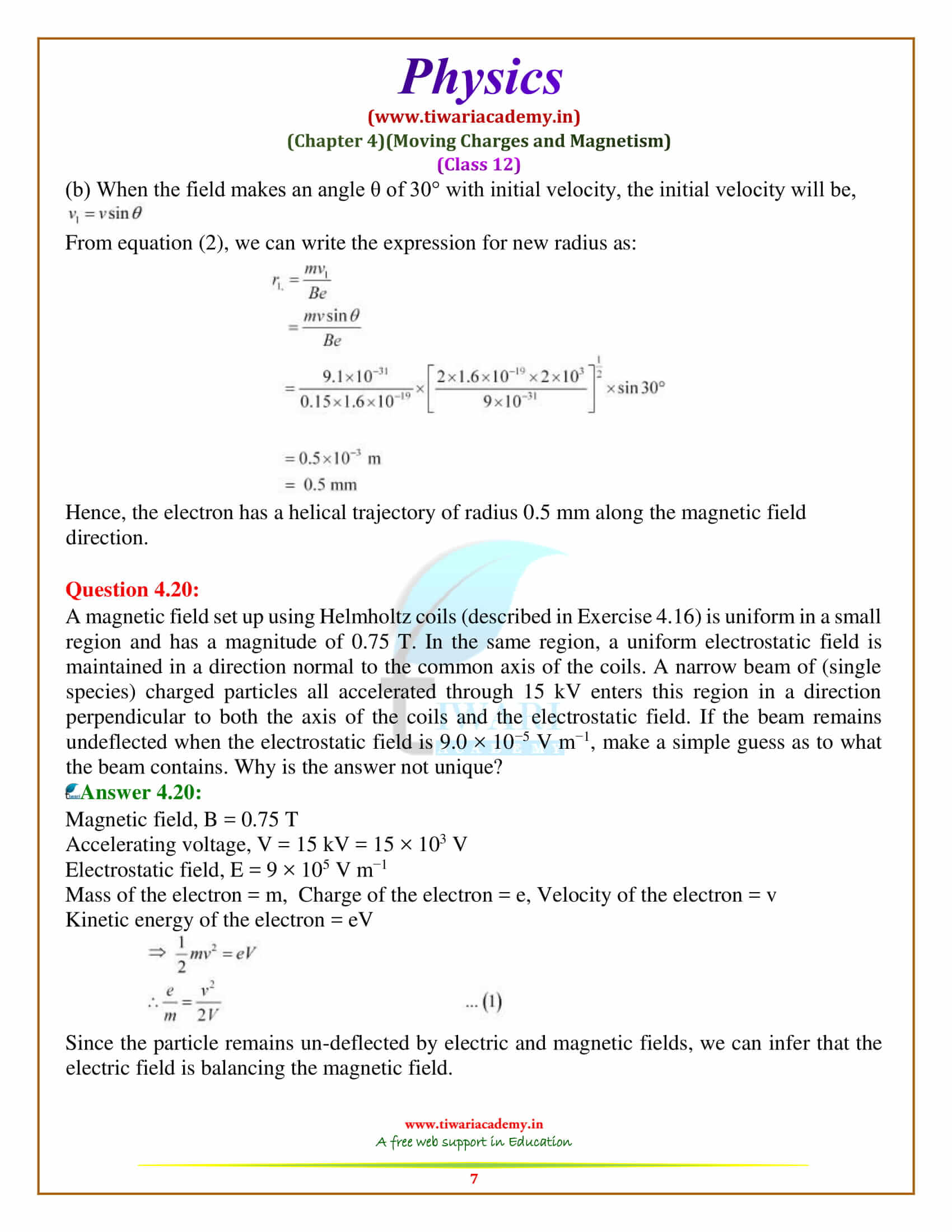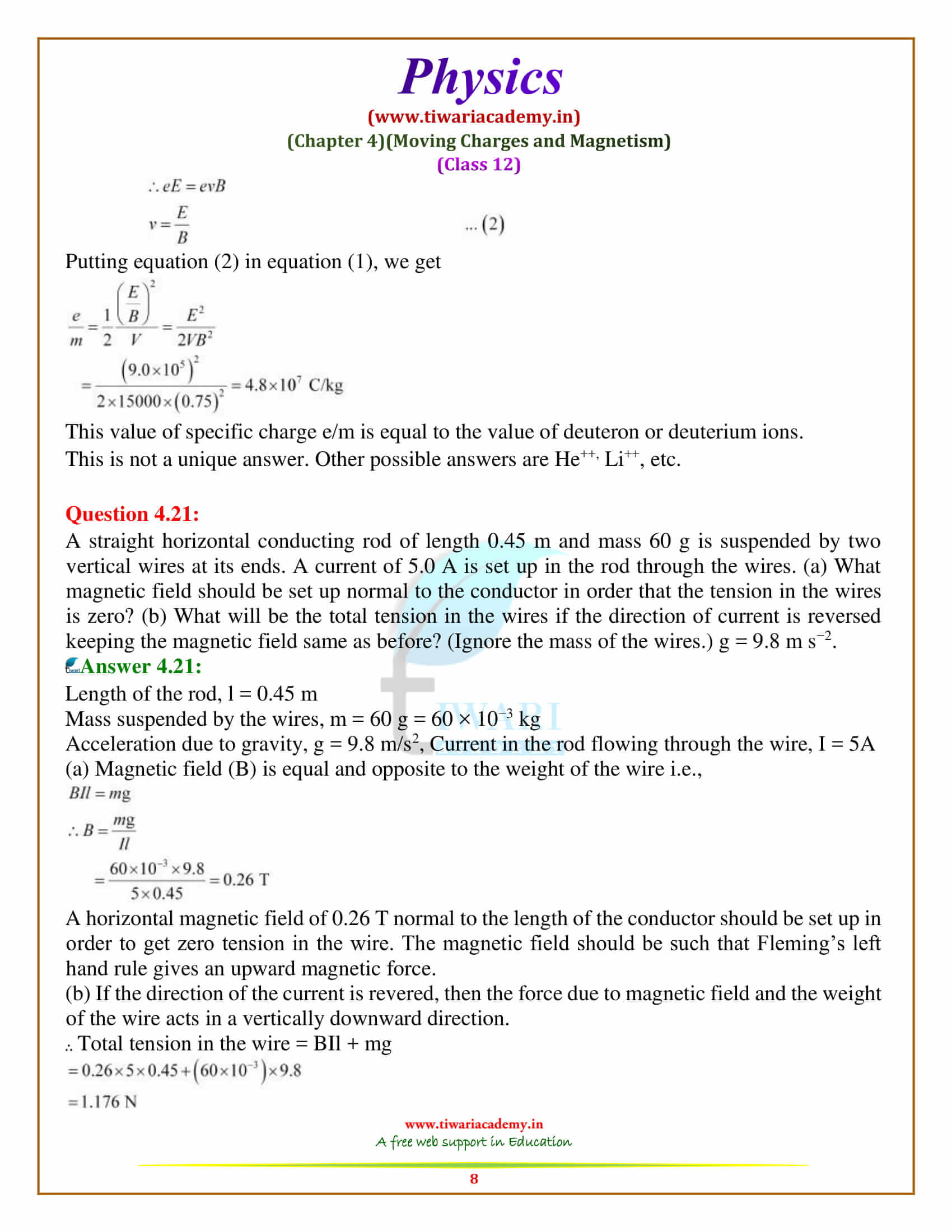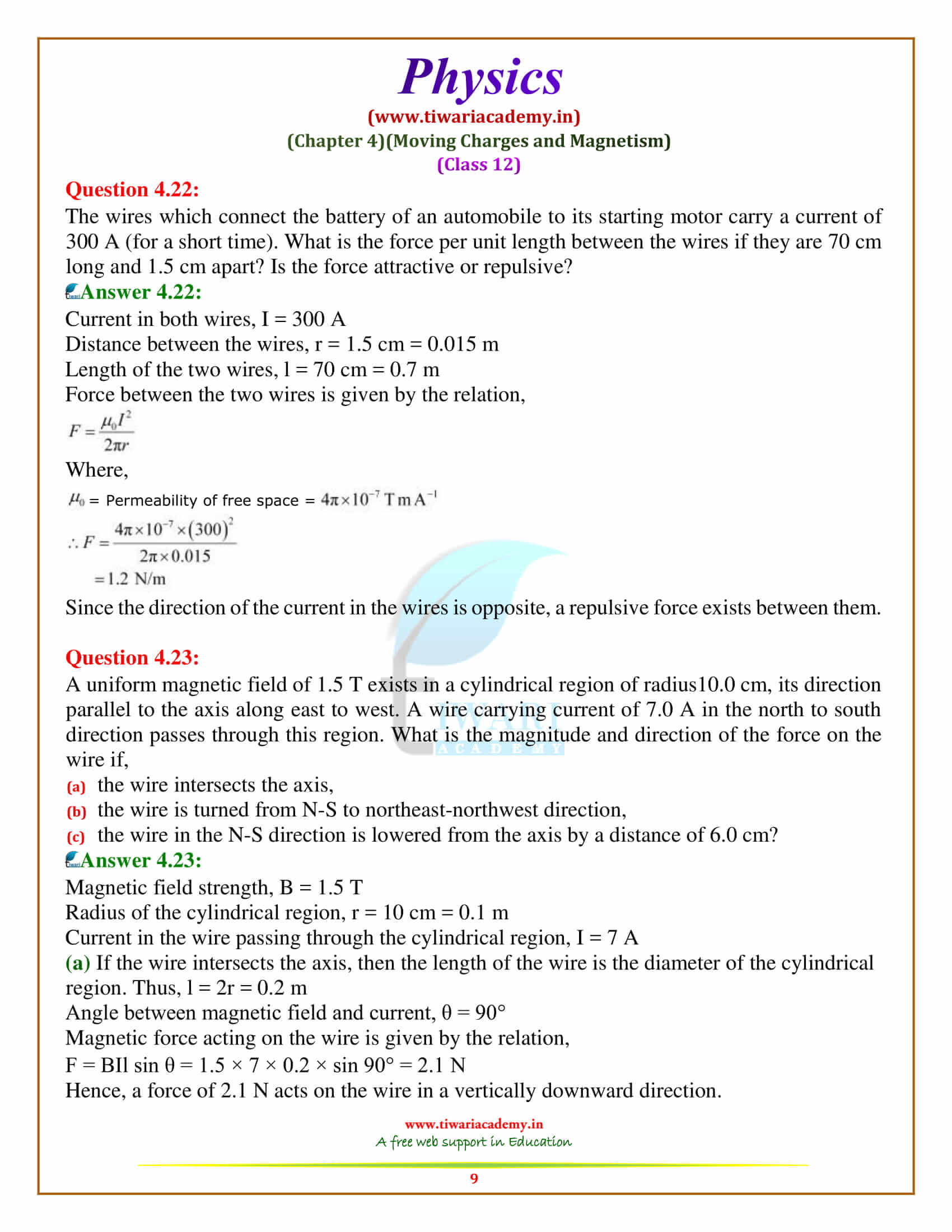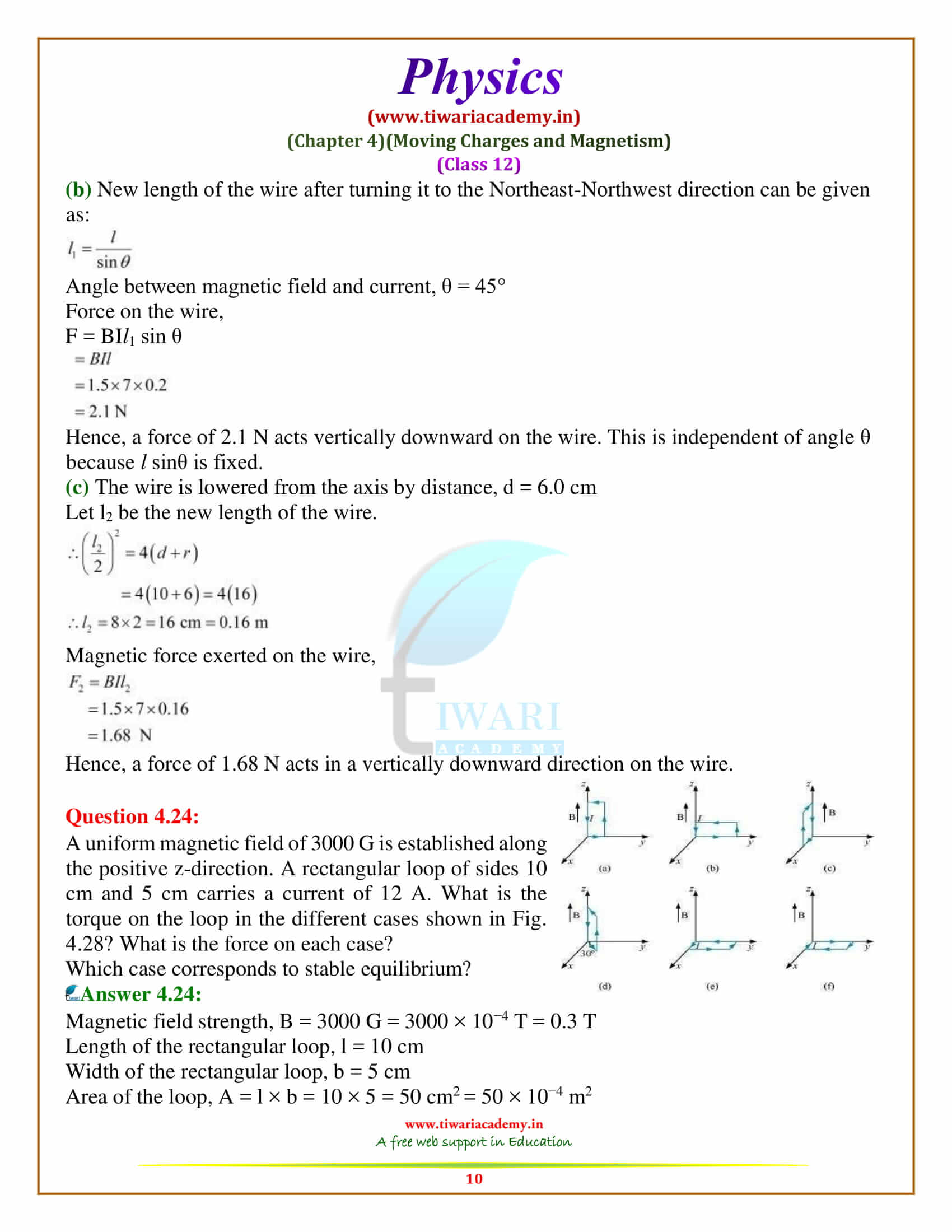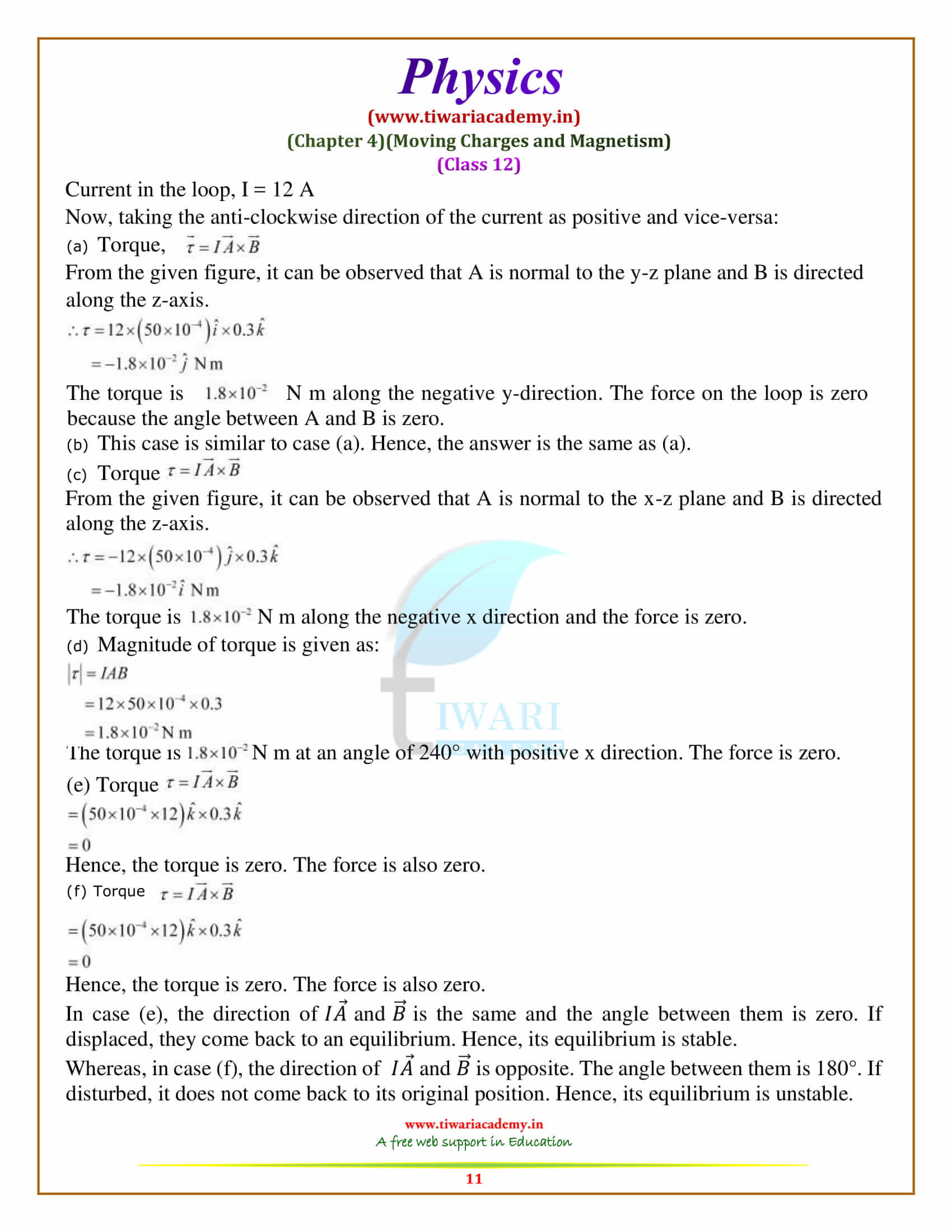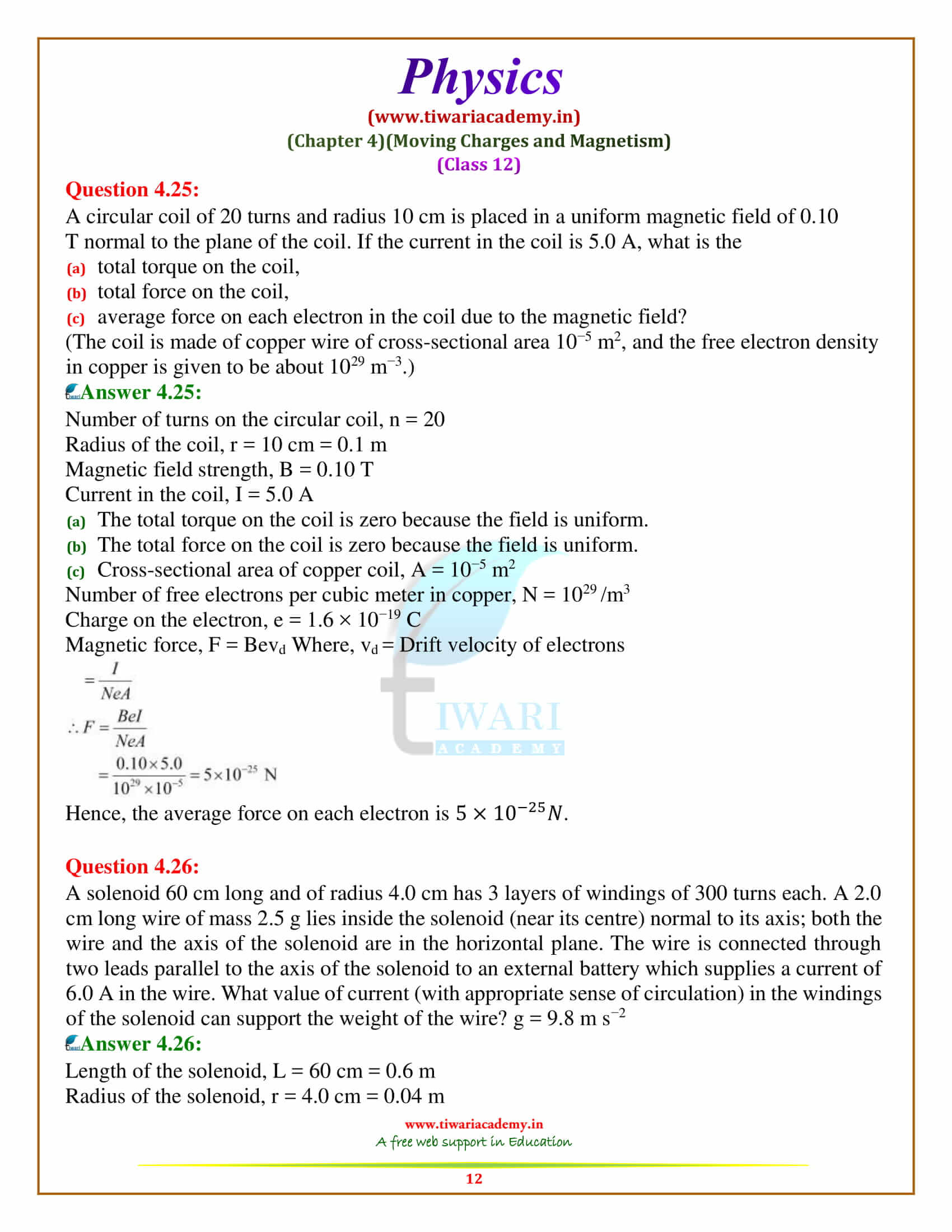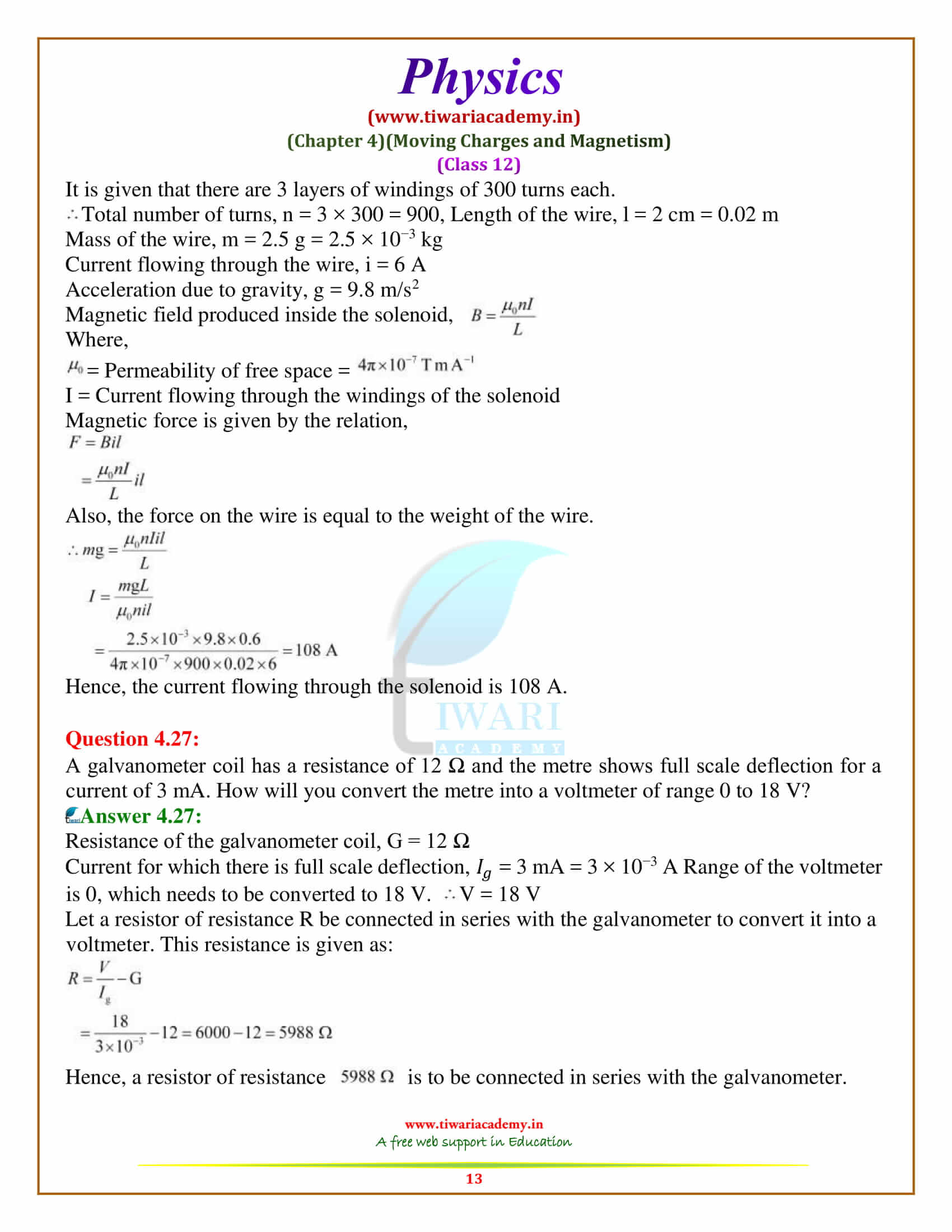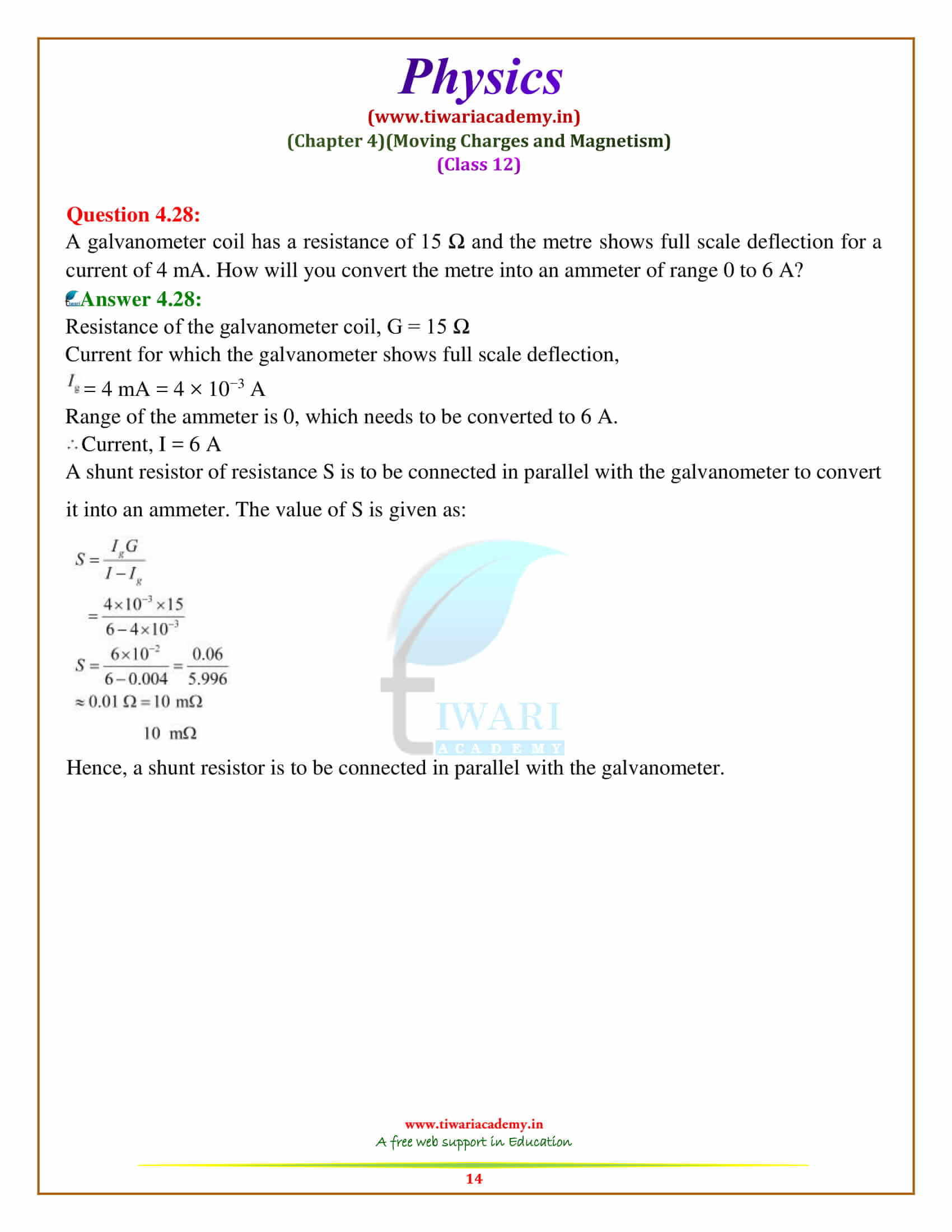NCERT Solutions for Class 12 Physics Chapter 4 Moving Charges and Magnetism chapter end Exercises Questions Answers and Additional Exercises Solutions in Hindi and English Medium for session 2025-26. As per the new NCERT textbooks, the additional exercises are not in syllabus for 2025-26 exams.
Viva Tips for Class 12 Physics
Preparation for Class 12 Physics Exam
Study Planner Class 12 CBSE Board
NCERT Solutions for Class 12 Physics Chapter 4
Chapter 4 Moving Charges and Magnetism Solutions
- Class 12 Physics Chapter 4 Exercises Solutions
- 12th Physics Chapter 4 Additional Exercises (Not in Syllabus)
- Class 12 Physics Chapter 4 Solutions in Hindi
- Class 12 Physics NCERT Book Chapter 4
- Class 12 Physics Revision Book Chapter 4
- Revision Book Answers
- Class 12 Physics Chapter 4 Revision Notes 1
- Class 12 Physics Chapter 4 Revision Notes 2
- Visit to 12th Physics Main Page
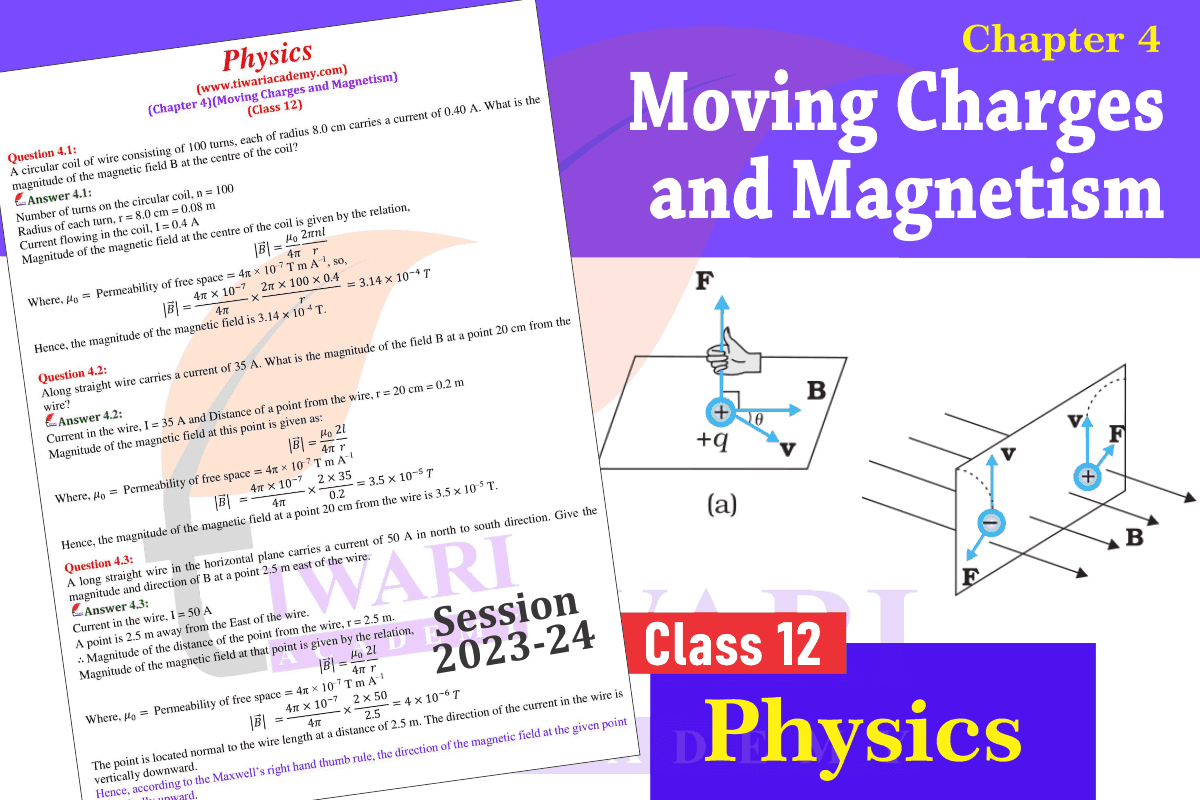
UP Board Solutions, NCERT Solutions and CBSE Offline Apps are updated according to new CBSE Books for 2025-26.
| Class: 12 | Physics |
| Chapter 4: | Moving Charges and Magnetism |
| Study Material: | Exercises and Extra Question Answers |
| Content Type: | Images, Text and Videos |
| Academic Session: | Year 2025-26 |
| Medium applied: | Hindi and English |
Class 12 Physics Chapter 4 Solutions in English
NCERT Solutions for Class 12 Physics Chapter 4 in PDF form to free download for academic session 2025-26. Ask your doubts related to NIOS or CBSE Board through Discussion Forum and response to the questions asked by others. Download NCERT Books 2025-26 based on latest CBSE Syllabus for UP Board, MP Board and other boards who are following CBSE Curriculum.
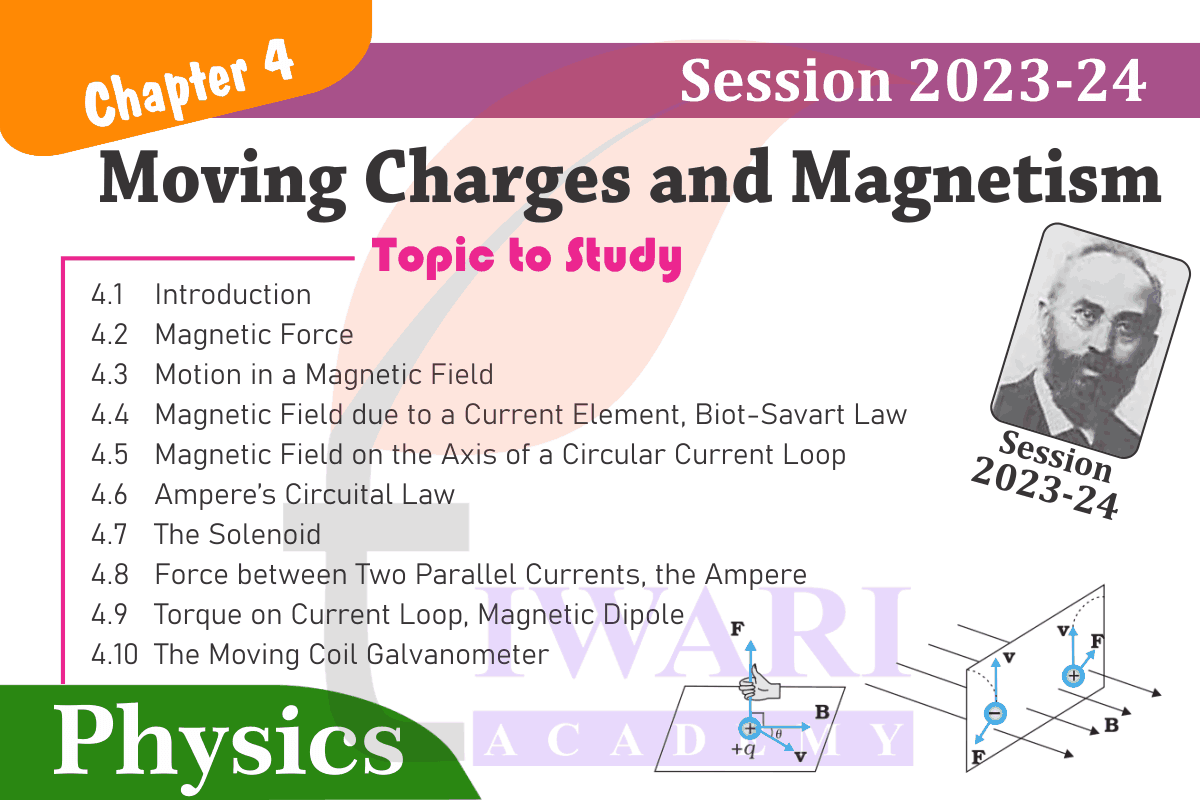
Important Questions for practice
1. An electric current flows in a horizontal wire from East to West. What will be the direction of magnetic field due to current at a point (i) North of wire; (ii) above the wire.
2. If the magnetic field is parallel to the positive y-axis and the charged particle is moving along the positive x-axis, which way would the Lorentz force be for (a) an electron (negative charge), (b) a proton (positive charge).
3. An electron beam projected along + x-axis, experiences a force due to a magnetic field along the + y-axis. What is the direction of the magnetic field?
4. In a circuit instantaneously voltage and current are V = 150 sin 314t volt and i = 12 cos 314 t ampere respectively. Is the nature of circuit is capacitive or inductive?
5. A wire moves with some speed perpendicular to a magnetic field. Why is emf induced across the rod?
Questions from Board Papers
1. Define RMS Value of Current. [Answer: RMS Value of ac is defined as that value of direct current which produces the same heating effect in a given resistor as is produced by the given alternating current when passed for the same time.]
2. A galvanometer of resistance 120 ohms gives full scale deflection for a current of 5mA. How can it be converted into an ammeter of range 0 to 5A? Also determine the net resistance of the ammeter.
3. A proton and an alpha particle of the same enter, in turn, a region of uniform magnetic field acting perpendicular to their direction of motion. Deduce the ratio of the radii of the circular paths described by the proton and alpha particle.
4. A magnetic dipole of magnetic moment M is kept in a magnetic field B. What is the minimum and maximum potential energy? Also give the most stable position and most unstable position of magnetic dipole.
5. A circular coil of n turns and radius R carries a current I. It is unwound and rewound to make another square coil of side ‘a’ keeping number of turns and current same. Calculate the ratio of magnetic moment of the new coil and the original coil.
Important Questions on 12th Physics Chapter 4
What is the magnitude of magnetic force per unit length on a wire carrying a current of 8 A and making an angle of 30º with the direction of a uniform magnetic field of 0.15 T?
Current in the wire, I = 8 A Magnitude of the uniform magnetic field, B = 0.15 T Angle between the wire and magnetic field, θ = 30°. Magnetic force per unit length on the wire is given as: f = BI sinθ = 0.15 × 8 ×1 × sin30° = 0.6 N/m Hence, the magnetic force per unit length on the wire is 0.6 N/m.
A 3.0 cm wire carrying a current of 10 A is placed inside a solenoid perpendicular to its axis. The magnetic field inside the solenoid is given to be 0.27 T. What is the magnetic force on the wire?
Length of the wire, l = 3 cm = 0.03 m Current flowing in the wire, I = 10 A Magnetic field, B = 0.27 T Angle between the current and magnetic field, θ = 90° Magnetic force exerted on the wire is given as: F = BIlsinθ = 0.27 × 10 × 0.03 sin90° = 8.1 × 10⁻² N Hence, the magnetic force on the wire is 8.1 × 10⁻² N. The direction of the force can be obtained from Fleming’s left hand rule.
A square coil of side 10 cm consists of 20 turns and carries a current of 12 A. The coil is suspended vertically and the normal to the plane of the coil makes an angle of 30º with the direction of a uniform horizontal magnetic field of magnitude 0.80 T. What is the magnitude of torque experienced by the coil?
Length of a side of the square coil, l = 10 cm = 0.1 m Current flowing in the coil, I = 12 A Number of turns on the coil, n = 20 Angle made by the plane of the coil with magnetic field, θ = 30° Strength of magnetic field, B = 0.80 T Magnitude of the magnetic torque experienced by the coil in the magnetic field is given by the relation, τ = n BIA sinθ Where, A = Area of the square coil = l × l = 0.1 × 0.1 = 0.01 m² So, τ = 20 × 0.8 × 12 × 0.01 × sin30° = 0.96 N m Hence, the magnitude of the torque experienced by the coil is 0.96 N m.
A circular coil of 30 turns and radius 8.0 cm carrying a current of 6.0 A is suspended vertically in a uniform horizontal magnetic field of magnitude 1.0 T. The field lines make an angle of 60º with the normal of the coil. Calculate the magnitude of the counter torque that must be applied to prevent the coil from turning.
Number of turns on the circular coil, n = 30 Radius of the coil, r = 8.0 cm = 0.08 m Area of the coil πr² = π(0.08)² = 0.0201 m² Current flowing in the coil, I = 6.0 A Magnetic field strength, B = 1 T Angle between the field lines and normal with the coil surface, θ = 60° The coil experiences a torque in the magnetic field. Hence, it turns. The counter torque applied to prevent the coil from turning is given by the relation, τ = n IBA sinθ = 30 × 6 × 1 × 0.0201 × sin60° = 3.133 N m
A magnetic field that varies in magnitude from point to point but has a constant direction (east to west) is set up in a chamber. A charged particle enters the chamber and travels undeflected along a straight path with constant speed. What can you say about the initial velocity of the particle?
The initial velocity of the particle is either parallel or anti-parallel to the magnetic field. Hence, it travels along a straight path without suffering any deflection in the field.
A charged particle enters an environment of a strong and non-uniform magnetic field varying from point to point both in magnitude and direction, and comes out of it following a complicated trajectory. Would its final speed equal the initial speed if it suffered no collisions with the environment?
Yes, the final speed of the charged particle will be equal to its initial speed. This is because magnetic force can change the direction of velocity, but not its magnitude.
An electron travelling west to east enters a chamber having a uniform electrostatic field in north to south direction. Specify the direction in which a uniform magnetic field should be set up to prevent the electron from deflecting from its straight line path.
An electron travelling from West to East enters a chamber having a uniform electrostatic field in the North-South direction. This moving electron can remain undeflected if the electric force acting on it is equal and opposite of magnetic field. Magnetic force is directed towards the South. According to Fleming’s left hand rule, magnetic field should be applied in a vertically downward direction.
